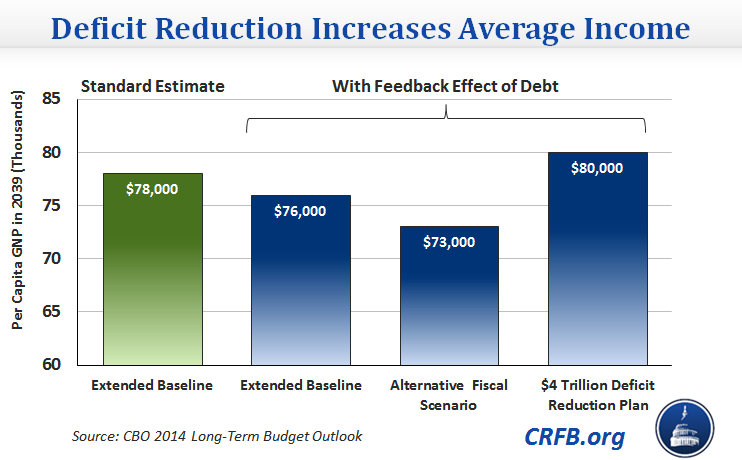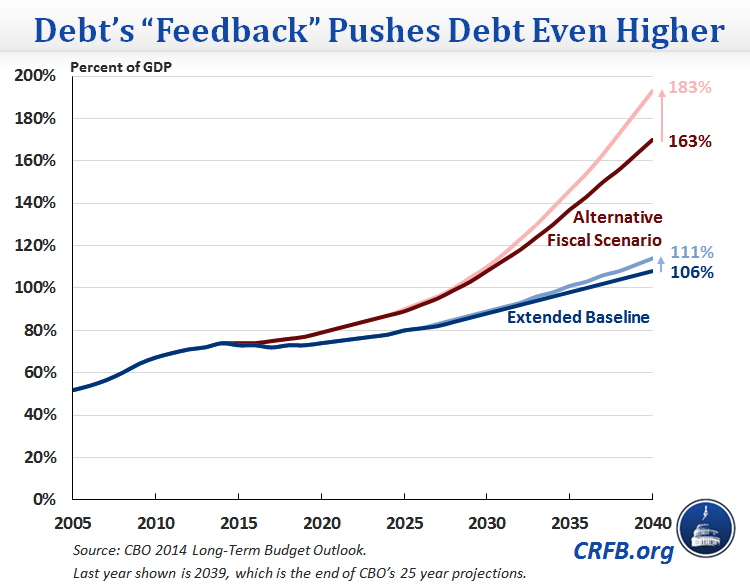High Debt Drags Down The Economy
New calculations in the Congressional Budget Office's Long-Term Budget Outlook show that the high debt projected under current law could diminish average annual income by $2,000 within 25 years, and that a $4 trillion debt reduction package would not only prevent that $2,000 hit but could also increase average income in the economy by another $2,000, among other findings.
The report details the economic drag that will be caused by our growing debt once the economy has fully recovered by the Great Recession, if Congress does nothing to address it. Under CBO's "Extended Baseline Scenario," debt would increase from its current 74 percent of GDP to exceed the size of the economy, reaching 108 percent of GDP, by 2040. Yet even the Extended Baseline Scenario is perhaps too optimistic in assuming that some provisions are allowed to expire as scheduled and that Congress won't take any more fiscally irresponsible decisions. CBO also projects an alternative baseline (the "Alternative Fiscal Scenario (AFS)"), which roughly illustrates what would occur if lawmakers continue current policies, keep non-health, non-Social Security spending from reaching historical lows, and do not allow taxes to continually increase as a result of "bracket creep." Under the AFS, debt skyrockets to 170 percent of GDP by 2040, over twice its current level.
CBO's standard budget estimates utilize historical trends of economic growth, inflation, and other variables. They do not, however, incorporate the effects of changing levels of debt on the economy, often called “feedback” or “dynamic" effects. In reality, high and growing debt levels will hinder long-term economic growth. In particular, CBO explains that "higher debt crowds out investment in capital goods and thereby reduces output relative to what would otherwise occur." In other words, high debt harms economic growth.
In its report, CBO has analyzed the harmful effects of debt. If its economic projections are modified to include these negative effects, the economy is 3 percent smaller in 25 years. If lawmakers return to their more profligate ways and follow the policies in the AFS, the economy will be another 5 percent smaller. In contrast, reducing the debt can lead to modest but real gains in economic growth: a 2 percent larger economy within 25 years.
A bigger economy means increased income for each individual. CBO also shows the effects on per-capita GNP, a rough proxy for average income. By 2039, GNP would be $78,000 per person before accounting for the negative effects of high debt levels, in today's dollars. If the economic drag from higher debt is included, per capita GNP drops to $76,000 – a $2,000 cut in income. If Congress continues profligate spending and increases debt to the levels in the AFS, GNP will drop by another $3,000, which means the average income will have dropped $5,000 dollars because of high debt.
On the flip side, a deficit reduction package of $4 trillion will put debt on a downward path as a share of the economy and increase per capita GNP by $2,000. Importantly, CBO's estimates of deficit reduction do not include any estimates of the types of tax and spending policies that are enacted. However, they note that higher effective marginal tax rates and larger transfer payments reduce output, while increased federal investment in education, infrastructure, and research and development can increase output. In effect, a smart deficit reduction plan that reforms the tax code and entitlements while increasing investments could increase economic growth even further.
Debt's "feedback" effect slows down economic growth. As a side effect, this slower economic growth will push debt even higher. Under the AFS, interest rates will increase by about three-quarters of a percentage point. As a result of higher interest rates and a slower economy, debt would rise to 183 percent of GDP, 20 points higher than if these feedback effects aren't included.
See our paper summarizing CBO's long-term outlook or the other entries in our blog series for more analysis.




